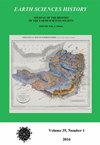‘EX PEDE HERCULEM’: SLOTHS, SLAVERY, AND SOUTHERN FOSSIL COLLECTION IN THE NINETEENTH CENTURY
IF 0.6
4区 哲学
Q4 GEOSCIENCES, MULTIDISCIPLINARY
引用次数: 0
Abstract
The Megatherium was thought to be a massive sloth-like creature that roamed different parts of the world including South America and coastal Georgia of the United States. Several nineteenth century naturalists collected and described fossilized remains of these large animals. Among those, the philosopher Samuel Latham Mitchell described them as ‘relics’ and new additions to the ‘giant brood’ of large animals in America. In his accounts, Mitchell did not acknowledge the original discoverers, enslaved African Americans. The discovery of the Megatherium in Georgia contributed to the discussion about distribution of those fossils; that discussion took place at venues such as the Lyceum of Natural History in New York. Using this case study, we seek to contextualize the importance of the Megatherium fossils collected in Georgia to the discourse about fossilized animals in the nineteenth century. The importance of slavery to fossil collecting in the South will also be analyzed.“ex pede hercullem”:树懒、奴隶制和19世纪南方的化石收集
大懒兽被认为是一种巨大的树懒状生物,生活在世界各地,包括南美洲和美国乔治亚州沿海地区。几位19世纪的博物学家收集并描述了这些大型动物的化石残骸。其中,哲学家塞缪尔·莱瑟姆·米切尔(Samuel Latham Mitchell)将它们描述为“遗迹”,是美国大型动物“巨巢”中的新成员。在他的叙述中,米切尔没有承认最初的发现者——被奴役的非裔美国人。乔治亚州大兽化石的发现促进了对这些化石分布的讨论;讨论在纽约的自然历史学园等场所进行。通过这个案例研究,我们试图将在格鲁吉亚收集的大兽化石的重要性放在19世纪关于化石动物的论述中。还将分析奴隶制对南方化石收集的重要性。
本文章由计算机程序翻译,如有差异,请以英文原文为准。
求助全文
约1分钟内获得全文
求助全文
来源期刊

Earth Sciences History
GEOSCIENCES, MULTIDISCIPLINARY-HISTORY & PHILOSOPHY OF SCIENCE
CiteScore
1.00
自引率
0.00%
发文量
1
审稿时长
>12 weeks
期刊介绍:
Earth Sciences History promotes and publishes historical work on all areas of the earth sciences – including geology, geography, geophysics, oceanography, paleontology, meteorology, and climatology.
The journal honors and encourages a variety of approaches to historical study: biography, history of ideas, social history, and histories of institutions, organizations, and techniques.
Articles are peer reviewed.
 求助内容:
求助内容: 应助结果提醒方式:
应助结果提醒方式:


